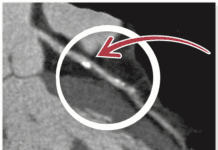When the left main coronary artery, which supplies blood to more than two-thirds of the heart, becomes narrowed or blocked (stenosis), the ejection fraction-the amount of blood the left ventricle can then pump out to the rest of the body-diminishes while the risk of heart failure increases. If the condition is too serious to treat with medication, patients may face the choice of having a drug-eluting stent (DES) placed in the artery to keep it open or having a coronary artery bypass graft (CABG) to re-route blood around the affected portion of the artery. Recently, the Unprotected Left Main Stenting Versus Bypass Surgery (LE MANS) study, reported in the Feb. 5 Journal of the American College of Cardiology, showed that left ventricular ejection fraction (LVEF) improved by an average of five percent among stent patients at 12 months, while CABG patients saw little to no improvement.
To continue reading this article or issue you must be a paid subscriber.
Sign in






